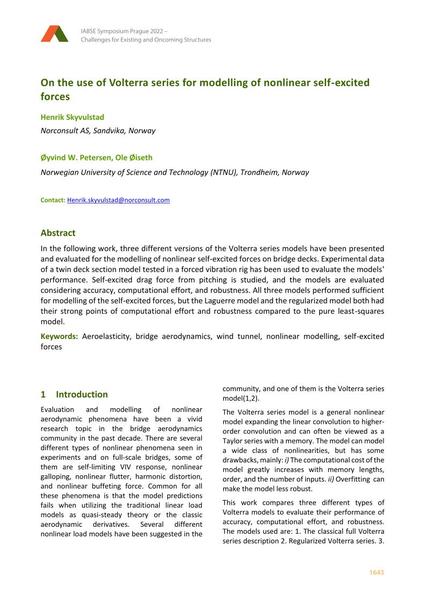On the use of Volterra series for modelling of nonlinear self-excited forces

|
|
|||||||||||
Bibliographic Details
| Author(s): |
Henrik Skyvulstad
(Norconsult AS, Sandvika, Norway)
Øyvind W. Petersen (Norwegian University of Science and Technology (NTNU), Trondheim, Norway) Ole Øiseth (Norwegian University of Science and Technology (NTNU), Trondheim, Norway) |
||||
|---|---|---|---|---|---|
| Medium: | conference paper | ||||
| Language(s): | English | ||||
| Conference: | IABSE Symposium: Challenges for Existing and Oncoming Structures, Prague, Czech Republic, 25-27 May 2022 | ||||
| Published in: | IABSE Symposium Prague 2022 | ||||
|
|||||
| Page(s): | 1643-1651 | ||||
| Total no. of pages: | 9 | ||||
| DOI: | 10.2749/prague.2022.1643 | ||||
| Abstract: |
In the following work, three different versions of the Volterra series models have been presented and evaluated for the modelling of nonlinear self-excited forces on bridge decks. Experimental data of a twin deck section model tested in a forced vibration rig has been used to evaluate the models' performance. Self-excited drag force from pitching is studied, and the models are evaluated considering accuracy, computational effort, and robustness. All three models performed sufficient for modelling of the self-excited forces, but the Laguerre model and the regularized model both had their strong points of computational effort and robustness compared to the pure least-squares model. |
||||
| Keywords: |
wind tunnel aeroelasticity self-excited forces bridge aerodynamics nonlinear modelling
|
||||
| Copyright: | © 2022 International Association for Bridge and Structural Engineering (IABSE) | ||||
| License: | This creative work is copyrighted material and may not be used without explicit approval by the author and/or copyright owner. |
||||
